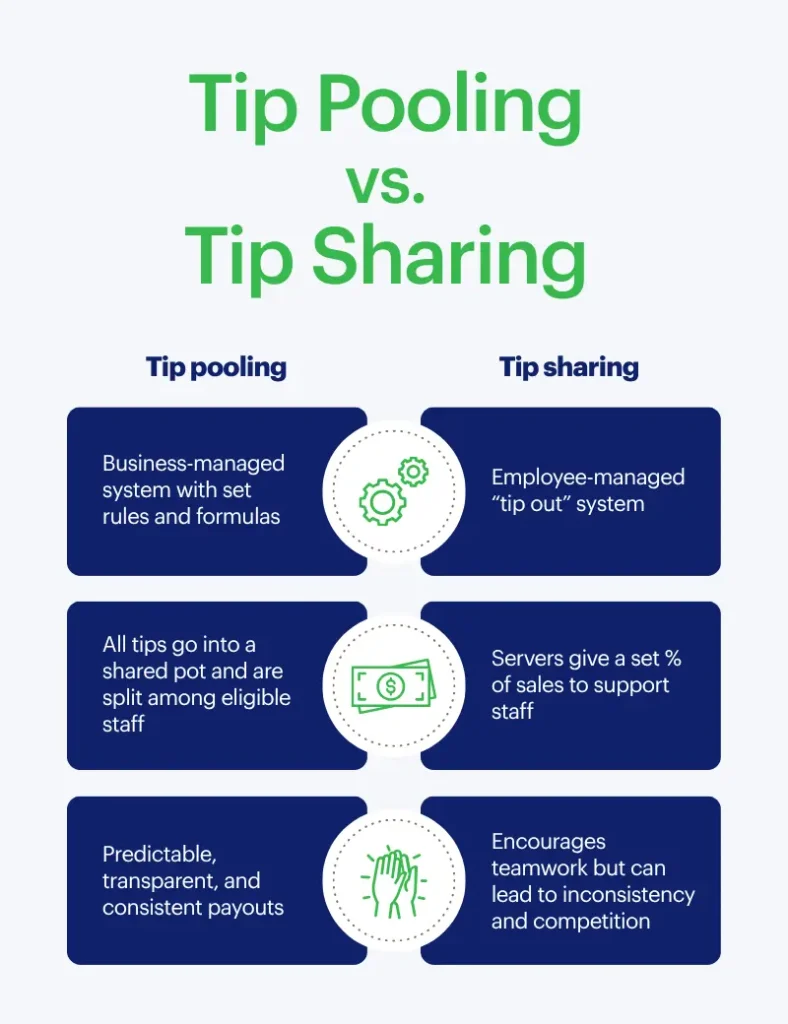Tip Pooling: What It Is, How It Works, and How to Do It Right

For hospitality and service industry employees, getting tipped out is the best part of the shift. For owners and managers…it can be a nightmare.
Splitting tips fairly is key to retaining employees, maintaining great service, and avoiding legal trouble. But tip pooling — one of the most common tip splitting methods — can be difficult to grasp and implement.
Whether you manage five or 50 employees, tip pooling can boost staff morale while streamlining your operations — so it’s worth understanding how to use this tip splitting method properly.
This guide breaks down:
- Exactly how tip pooling works
- The pros and cons of different tip pooling methods
- Legal considerations around tip pooling
- How to simplify tip pooling with digital tipping software
What is tip pooling?
Tip pooling is a system where tips earned during a shift are collected into a shared pool and then redistributed among the team. Instead of each employee keeping only what they personally earned, everyone who’s part of the pool gets a portion based on a set formula.
So what is that formula?
Tip pooling formulas might consider things like:
- Hours worked
- Job role
- A point system that weighs different positions
The idea is that instead of one person walking away with a windfall while others walk away with pennies, tip pooling ensures everyone who contributed to the guest experience gets their fair share. Businesses that use tip pooling find that it fosters a sense of teamwork among staff and levels the playing field for BOH and other non-customer-facing employees.
Is tip pooling a good idea?
Tip pooling can be a good idea for businesses that implement and execute it well.
Data from Toast indicates that 39% of hospitality employees who participate in a tip pool either like or love it. Meanwhile, 46% of tipped employees (no tip pool) report disliking or hating it.
This goes to show that implementation is half the battle.
In some businesses, tip pooling can create parity across shifts. In others, it may demotivate staff who thrive on performance-based income. It all comes down to clarity, fairness, and staff buy-in.
All the while, tip pooling can also help address inequities in tipping across roles. For example, a bartender and a food runner are both critical to guest service but receive wildly different tip amounts in a tip-out system. Pooling gives everyone a fair piece of the pie.
Pros and cons of tip pooling
Pros
- Promotes teamwork and shared accountability
- Reduces resentment toward prime shifts or stations
- Supports back-of-house or non-tipped staff
- Simplifies tip tracking and compliance for managers
- Prevents guest confusion about who to tip
- May support more consistent service quality across staff
Cons
- High performers might feel penalized
- Poor implementation can lead to morale issues
- Legal compliance can be complex without the right tools
- Can be seen as less transparent if not communicated clearly
- May reduce motivation for upselling or hustle
How tip pooling works in restaurants, hotels, and more
A tip pool at one business is going to look different than a tip pool at another — and that’s the point. The way you set up and manage a tip pool should reflect the unique rhythm of your operation.
The basics of tip pooling in restaurants
Given the nature of the business — with equal parts FOH and BOH, where the BOH doesn’t interact with customers — tip pooling is an extremely common method of tip distribution in restaurants.
Pooled tip sharing in restaurants usually means combining the tips collected during a shift — from servers, bartenders, bussers, food runners, and hosts — into a shared pot. That pot is then divided based on a clear formula.
This structure makes sure that all team members who play a role in delivering a great guest experience benefit from tips, not just those who happen to take the order or deliver the check. It also minimizes tension between front-of-house staff working different stations or shifts.
Restaurant operators may choose to pool all tips, or only a portion of them. For example, a server might keep 30% of their own tips while contributing the other 70% to the pool.

Tip pooling beyond restaurants
Restaurants aren’t the only businesses that rely on team-based service. Tip pooling is also common in:
- Hotels, where housekeepers, bellhops, valets, and concierges all contribute to the guest experience
- Spas and salons, where stylists, assistants, and receptionists work together to serve clients
- Bars and nightclubs, where bartenders, barbacks, and cocktail servers all support the same flow of service
- Valet and shuttle services, where drivers, runners, and dispatchers all work together
In these environments, tip pooling can help equalize earnings across roles that are equally essential but not always visible to the guest. It can also help prevent “tip favoritism” — for example, when a concierge gets all the credit for something a bellhop made happen.
Tip pooling vs. tip sharing
It’s easy to confuse tip pooling and tip sharing — they both involve splitting tips, after all. But the way they’re executed (and how they feel to your team) are very different.
Tip pooling is a structured system managed by the business.
Management sets the rules ahead of time, tips are collected into a shared pot, and everyone eligible gets a defined cut based on a formula. It’s clear, predictable, and built into your operations.
Tip sharing, on the other hand, puts tip distribution in the hands of tipped employees.
A server, for example, might earn $200 in tips during a shift and then “tip out” 10% to the bartender and 5% to bussers or food runners. This is usually based on a percentage of sales, not the total tips received.
It’s a way to recognize the team effort that goes into each guest experience, while still letting servers keep the bulk of what they earned.

So what’s the difference?
Tip sharing tends to incentivize both the tipped employee and the support team: the more successful the shift, the more everyone earns. But it can also introduce inconsistency, competition over better sections, and confusion about expectations.
In contrast, tip pooling offers more transparency and uniformity — which is why many operators prefer it for scaling teams, simplifying compliance, and avoiding payout disputes.
Tip pooling methods (with examples)
There’s no universal playbook for tip pooling — and that’s a good thing. The best method of tip pooling depends on your team size, service model, and what “fair” looks like to your staff.
Here are some of the most common tip pooling approaches to help you choose what works best for your business:
Percentage-based pools
In a percentage-based pool, employees contribute a fixed percentage of their tips — often 100%, but sometimes less — to a shared pot that’s divided among eligible staff.
Example: A restaurant’s tip pooling policy is for servers to add 70% of their tips to the pool while keeping 30%. A server who earns $300 in tips during a shift contributes $210 to the pool, while a server who earned $200 that shift contributes $140.
Pros:
- Simple to implement
- Easy to track
- Scales across multiple departments
Cons:
- Can feel unfair to top earners
- May demotivate high performers during busy shifts
Point-based tip pooling system
A tip pool point system assigns each role a point value that reflects their level of contribution. Tips are distributed proportionally based on the total number of points worked in a shift.
Example:
- Server = 10 points
- Bartender = 8 points
- Host = 5 points
- Busser = 2 points
Let’s say there were 4 servers, 1 bartender, 2 hosts, and 1 busser during a shift.
- 4 servers = 40 points
- 1 bartender = 8 points
- 2 hosts = 10 points
- 1 busser = 2 points
That means there were 60 total points.
If the team earned $600 in tips during a shift, the value of one point is $10 ($600 / 60).
That means each team member would earn:
- Server: $100
- Bartender: $80
- Host: $50
- Busser: $20
Pros:
- Highly customizable
- Recognizes differences in workload or seniority
- Transparent for large teams with many roles
Cons:
- Requires more setup and tracking
- Needs to be updated regularly if roles or responsibilities shift
Shift-based splits
This model pools and distributes tips based on shift schedules — morning vs. evening, opening vs. closing, etc. It’s especially useful in 24/7 operations or where service style changes throughout the day.
Example:
The AM team and PM team each pool their own tips. Tips are distributed within each shift separately.
Pros:
- Keeps distribution aligned with when tips were earned
- Avoids cross-shift disputes
Cons:
- Less flexibility with staff who work partial or overlapping shifts
- Doesn’t account for variation in shift volume
Role-based splits
In a role-based model, tips are distributed according to the employee’s job title and how much that role contributes to the guest experience. This method recognizes that some positions, like servers and bartenders, interact with guests more directly and frequently — and therefore usually receive a larger share of the pooled tips.
Example:
A restaurant may determine that servers and bartenders receive 70% of the pooled tips, while the remaining portion is divided among hosts, bussers, and other support staff. The exact split depends on how each role supports service and how close they are to the customer.
This system ensures that tips are distributed in proportion to the level of customer interaction and responsibility, while still acknowledging the vital role of back-of-house or non-tipped staff.
Pros:
- Reflects the hierarchy of guest interaction
- Easy to adjust as team composition evolves
- Helps create a sense of fairness without overcomplicating the math
Cons:
- Can feel arbitrary without clear communication
- Needs to be reviewed regularly to ensure it reflects how the team operates
Workday (hours worked) tip pooling
This method is based purely on how many hours each employee worked that day. It’s straightforward and widely used in hourly operations.
Example:
- Total pooled tips: $900
- Total hours worked by all eligible employees: 45
- Each hour worked = $20 in tips
- Someone who worked 5 hours earns $100; 10 hours earns $200
Pros:
- Very easy to track and explain
- Feels fair when roles have similar workloads
Cons:
- Doesn’t account for intensity of work or role complexity
- May disincentivize faster-paced roles who generate more tips per hour
| Method | How It Works | Best For | Pros | Cons |
| Percentage-Based Pool | Employees contribute a set percentage of their tips to a shared pool | Simple operations needing quick setup | Easy to implement and track | May feel unfair to high earners |
| Point-Based System | Each role is assigned a point value; tips are distributed based on total points worked. | Large teams with varied roles | Highly customizable, fair across roles | Requires setup and updates |
| Shift-Based Splits | Tips are pooled and distributed within each shift (AM vs. PM, etc.). | 24/7 businesses with clear shift divides | Aligns tips with shift effort | Doesn’t adjust for shift volume |
| Role-Based Splits | Tips are split based on job title and customer interaction levels. | Operations with clear guest interaction hierarchies | Recognizes role responsibility | Can feel arbitrary if not explained well |
| Workday (Hours Worked) | Tips are divided by total hours worked; employees are paid proportionally per hour. | Hourly teams with similar roles and workloads | Straightforward and transparent | Doesn’t reflect role intensity or pace |

Tip pooling resources
Managing a tip pool doesn’t stop at choosing a method or writing up a policy — you also need tools to help you execute and stay compliant.
Tip pooling calculator
Manually calculating pooled tips might sound simple at first — but once you start factoring in hours worked, role-based point systems, shift overlaps, and custom splits, it can quickly turn into a mess of spreadsheets, side calculations, and second-guessing.
A tip pooling calculator will save your sanity.
A good calculator lets you plug in different pooling methods (like percentage-based or point-based models) and immediately see how the money should be distributed across your team. That way, you can compare outcomes, test different structures, and figure out what’s truly fair and efficient for your operation — without doing the math by hand.
Use our free tip pooling calculator to explore different payout structures, compare scenarios, and take the guesswork out of your tip pool.

Tip pooling laws
Unfortunately, tip pooling can become a legal mess if you don’t know the rules.
And those rules change depending on where you are and how your business is structured.
At the federal level, the Fair Labor Standards Act (FLSA) lays out the foundation.
According to the FLSA:
- Only tipped employees can participate in a pool (unless you’re paying everyone full minimum wage — no tip credit involved).
- Supervisors and managers are almost always excluded, unless they regularly perform tipped duties (and even then, it’s tricky).
- Businesses must keep accurate records — tip amounts, who received what, and when — to stay compliant with both the IRS and Department of Labor.
But here’s the kicker: States often add their own rules on top of the federal ones.
Is tip pooling legal in all states?
Some states completely prohibit certain kinds of tip pooling. Others are more relaxed. And in many cases, tip sharing laws and server tip out laws vary wildly from one county to the next.
When in doubt, loop in your legal or HR team. And if you want to make compliance easier, choose a digital system like eTip that tracks everything automatically and gives you clean records for audits.
Related reading → Consequences of Not Reporting Cash Tips
How to create a tip pooling policy for your business
A good tip pooling policy covers three things:
- Who’s in the pool
- How tips are distributed
- When payouts happen
But even more importantly, it helps set expectations across your team. Your policy should eliminate guesswork, build trust, and keep things running smoothly during busy shifts.
Start by thinking about how your team works together on the floor. Is there a clear divide between front-of-house and back-of-house? Do certain roles deserve a greater share based on guest interaction or workload? Your answers should shape the structure you choose.
Tip pooling policy checklist:
✅ Define eligible employees
✅ Choose a pooling method (percentage, point, role-based, etc.)
✅ State distribution frequency (daily, weekly, payroll-based)
✅ Document how tips are tracked and paid
✅ Train staff on expectations and transparency
Simplify tip pooling with eTip
Running a tip pool shouldn’t feel like a full-time job. With eTip, it isn’t.
eTip is the #1 digital tipping solution for hospitality and service businesses, trusted by Marriott, Hilton, Hyatt, and thousands more.

Our platform helps:
- Automate customizable tip allocations
- Split tips by shift, role, or hours worked
- Payout tips instantly or via payroll
- Track every tip in a user-friendly dashboard
- Eliminate disputes, delays, and human error
And unlike others, we don’t force you into third-party payment platforms. eTip has its own sponsor bank, FBO account, and top-tier compliance (PCI, SOC2).
Want to boost staff retention, streamline operations, and eliminate tip chaos? Book a demo with eTip and simplify your tip pooling for good.
Join the eTip community!
We'll send the latest content & special releases directly to your inbox.
Ready to join the community?
Receive the latest & greatest content from eTip, sent directly to your preferred inbox!
![[CTA] Image - Generic 2 - 1200 x 627](https://no-cache.hubspot.com/cta/default/6775923/interactive-190476979840.png)

